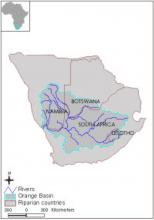Informations générale

| Nom | Fonction |
|---|---|
|
Mr. Boikanyo Mpho
|
Interim Secretary
|
Données de base
Varies from 35 mm/year to 1000 mm/year with a mean value of 325 mm/year over the basin.
The irrigation potential for the basin is estimated at 390,000 ha of which 303,000 ha are presently irrigated.
Site Internet
Couverture géographique
The Orange-Senque river originates from Lesotho highlands and is joined by the Makhaleng, Caledon, Vaal and Fish rivers.
| Pays | Superficie |
|---|---|
|
Botswana
|
121400km²
|
|
Lesotho
|
19900km²
|
|
Namibie
|
240200km²
|
|
Afrique du sud
|
563900km²
|
Fonction/mandat
ORASECOM through the Council serves as technical adviser to the Riparian Countries on the development, utilization, and conservation of the water resources of the basin. The Commission was mandated to develop a comprehensive perspective of the basin, study the present and planned future uses of the river system, and determine the requirements for flow monitoring and flood management. The main objective was the realization of the principle of equitable and reasonable utilization, as well as the principle of sustainable development with regard to the River System.
Fonctionnement
The Council is the highest body of ORASECOM supported by a task team of consultants and donors. A permanent secretariat is planned.
A Council, which is the highest body of the Commission, is supported by a Task Team made up of consultants, donors etc. The Council consists of the participating countries` delegations, each having three members. The Council meets at least once a year.
The Orange-Senqu basin has been selected as one of the target basins of the EU Water Initiative. (EUWI). It has presented a portfolio of projects to the EUWI relating to the harmonization of the legislation in the Riparian Countries, the study of transboundary aquifers, water demand management, a basin information system, capacity building, and stakeholder participation. The Commission is to undertake a joint assessment of all the resources of and uses in the basin with the aim of developing an integrated water resources management plan.
The Parties were required to exchange available information and data regarding the hydrological, hydro-geological, water quality, meteorological, and environmental conditions of the River System. A Party planning any project, program, or activity with regard to the River System which may have a significant adverse effect upon any one or more of the other Parties, or which may adversely affect such River System, must notify the Council and provide all available data and information with regard thereto.
The Council shall make every effort to take decisions on the basis of consensus. No decision of the Council shall be valid unless taken at a meeting attended by at least three of the delegations. In the event of failure to reach agreement at such a meeting of the Council, the matter shall be made the subject of negotiations between the Parties. Any dispute between the Parties arising out of the interpretation or implementation of this Agreement shall be settled amicably through consultation and/or negotiation between them. In case of a dispute, decisions are transferred to the political level. If a dispute cannot be resolved, the case is referred to the SADC Tribunal whose decisions are final and binding
ORASECOM is financed by the respective Ministries responsible for the management of water resources of the member states. Each member state covers the costs of its delegation. Meetings are financed by the hosting member state. All further costs or liabilities incurred by the Commission are equally covered by all member states.
The Council shall take all measures required to make recommendations, or to advise the Parties, on the extent to which the inhabitants in the territory of each Party concerned shall participate in respect of the planning, development, utilization, protection and conservation of the River System, as well as the harmonization of policies in that regard and the possible impact on the social, cultural, economic and natural environment
In 1992, South Africa and Namibia established a Permanent Water Commission (PWC) to advise the governments on the development of the Lower Orange River. The PWC replaced the Joint Technical Committee, which was established in 1987. Namibia also entered into an agreement with South Africa on the establishment of a joint authority for an irrigation scheme that is linked with the PWC on the Lower Orange River. Lesotho and South Africa signed an agreement on the Lesotho Highlands Water Project (LHWP) in 1986, which eventually led to the establishment of the Lesotho Highlands Water Commission (LHWC). After a long process of negotiations, the Orange-Senqu River Commission (ORASECOM) was established as the first multinational, multilateral institution dealing with the management of the transboundary water system.
Bases légales
| Date | Nom du traité | Signataires | Bassin |
|---|---|---|---|
|
1986-10-24
|
Lesotho Water Project Treaty
|
Lesotho
|
Bassin de l'Orange
|
|
1991-11-19
|
Protocol IV on Water Treaty
|
Lesotho
South Africa
|
Bassin de l'Orange
|
|
1992-08-31
|
Ancillary Agreement
|
Lesotho
South Africa
|
Bassin de l'Orange
|
|
1992-09-14
|
Permanent water Commission
|
Namibia
South Africa
|
Bassin de l'Orange
|
|
1999-01-01
|
Protocol VI on Water treaty
|
Lesotho
South Africa
|
Bassin de l'Orange
|
|
2000-11-03
|
Formation of ORASECOM Agreement
|
Botswana
Lesotho
Namibia
South Africa
|
Bassin de l'Orange
|
Challenges
River being perennial but seasonal in nature, supporting a substantial part of South Africa’s growing industrial development, rising demand for irrigation water, environmental impacts of abstraction, construction of infrastructure necessitated by high water demand and a secretariat in a difficult operationalization phase.
 AWIS/Sadieau
AWIS/Sadieau